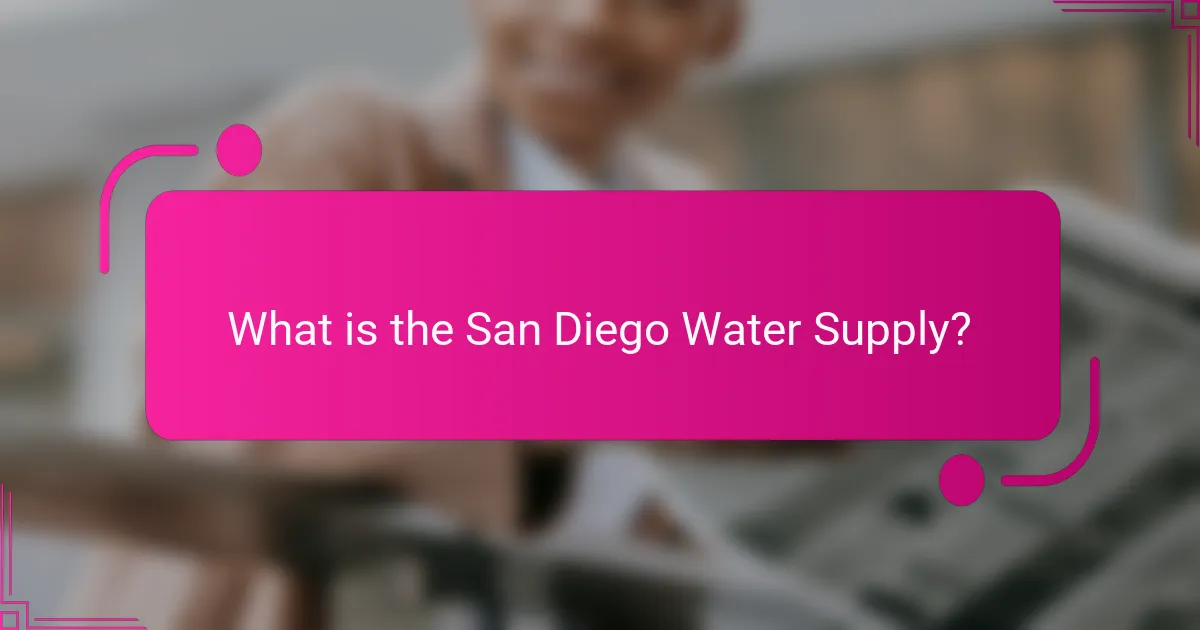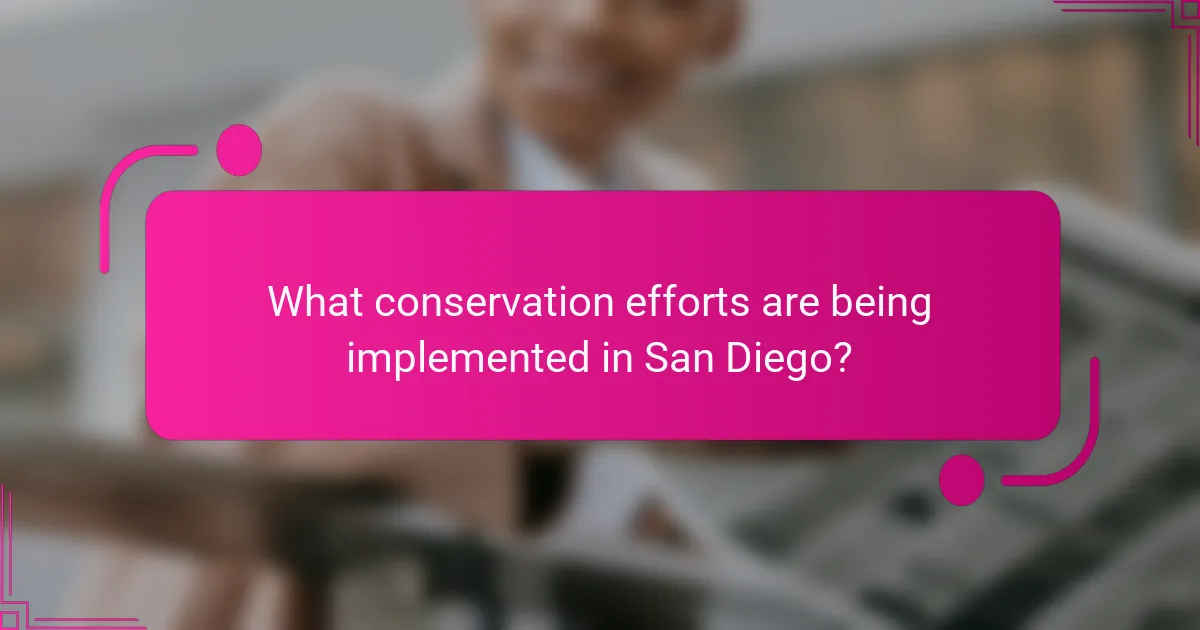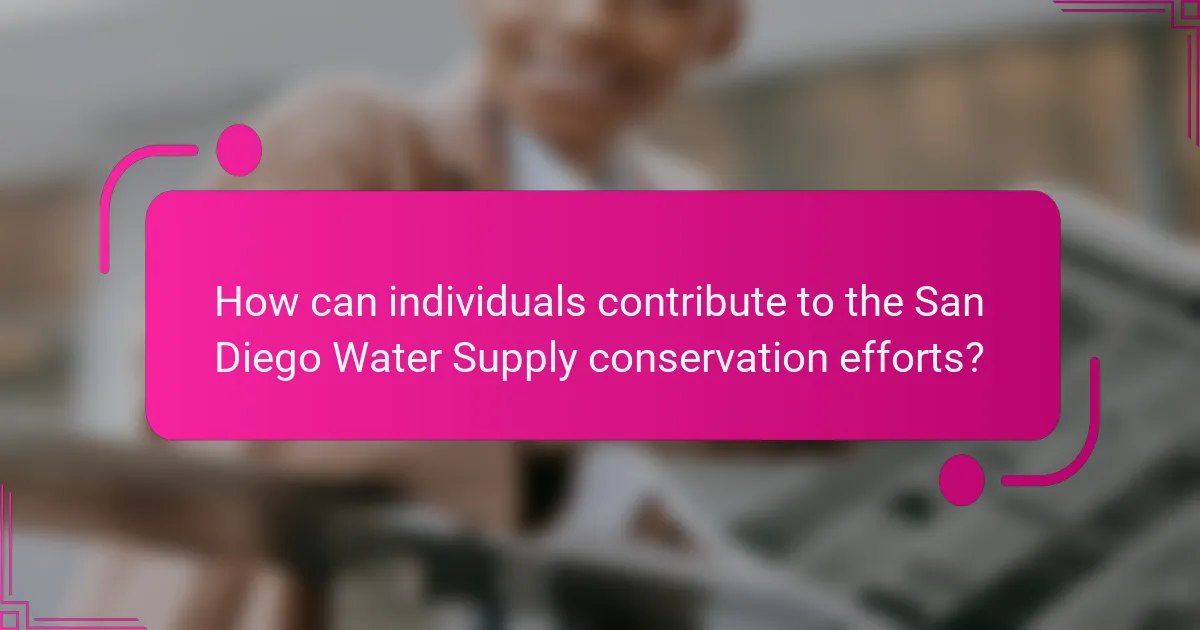
What is the San Diego Water Supply?
The San Diego Water Supply is the system that provides water to the San Diego region. It includes a combination of local water sources and imported supplies. Key sources include the Colorado River and the State Water Project. The supply is managed by the San Diego County Water Authority. This authority oversees the distribution and conservation of water resources. San Diego’s water supply also relies on groundwater from local aquifers. Additionally, recycled water is used for irrigation and non-potable purposes. The region faces challenges such as drought and increasing demand. Conservation efforts are vital to ensure a sustainable water supply for the future.
How is the San Diego Water Supply sourced?
The San Diego Water Supply is sourced from multiple regions. The primary sources include local reservoirs, groundwater, and imported water. Local reservoirs capture rainwater and runoff. Groundwater is extracted from aquifers beneath the region. Imported water comes from the Colorado River and the State Water Project. Approximately 80% of San Diego’s water supply is imported. The region relies on these diverse sources to meet its water needs. This sourcing strategy helps ensure reliability and sustainability for the community.
What are the primary water sources for San Diego?
The primary water sources for San Diego are imported water, local groundwater, and recycled water. Imported water comes from the Colorado River and Northern California through the Metropolitan Water District. Local groundwater is drawn from the San Diego Basin, which is replenished by rainfall and conservation efforts. Recycled water is treated wastewater used for irrigation and industrial purposes. In 2020, approximately 80% of San Diego’s water supply was imported. The city actively promotes water conservation to manage its limited resources effectively.
How does the climate affect the water supply in San Diego?
Climate significantly affects the water supply in San Diego. The region experiences a Mediterranean climate with dry summers and mild, wet winters. This seasonal pattern influences local water availability. During dry periods, rainfall decreases, leading to reduced water inflow to reservoirs. San Diego relies heavily on imported water, making it vulnerable to climate variability. Drought conditions can exacerbate water shortages, impacting agricultural and urban needs. According to the San Diego County Water Authority, climate change is projected to increase the frequency and severity of droughts. This poses challenges for long-term water sustainability in the region.
What challenges does the San Diego Water Supply face?
The San Diego Water Supply faces several significant challenges. One major challenge is limited local water resources. San Diego relies heavily on imported water, primarily from the Colorado River and Northern California. This dependence makes the supply vulnerable to droughts and climate change impacts. Another challenge is the increasing demand for water due to population growth. The city’s population has been steadily rising, leading to higher water consumption. Additionally, aging infrastructure poses risks for water delivery and quality. Many pipelines and treatment facilities require upgrades or replacement. Lastly, regulatory and environmental constraints complicate water management strategies. These factors collectively threaten the sustainability of San Diego’s water supply.
How does population growth impact water supply?
Population growth significantly impacts water supply by increasing demand for water resources. As more people inhabit an area, the consumption of water for residential, agricultural, and industrial purposes rises. In San Diego, population growth has led to higher water usage rates, straining existing water supplies. For instance, a study by the San Diego County Water Authority indicated that water demand could increase by up to 20% by 2035 due to population growth. This heightened demand can lead to resource depletion and increased competition for water. Additionally, population growth can exacerbate issues related to water quality and availability, making conservation efforts crucial to ensure sustainable water supply.
What role does drought play in water availability?
Drought significantly reduces water availability. It leads to decreased precipitation and lower river flows. This reduction impacts reservoirs and groundwater levels. For example, California experienced severe droughts from 2012 to 2016. During this period, water storage in reservoirs dropped by 50%. Consequently, water supplies for agriculture and urban use diminished. Drought conditions force communities to implement water conservation measures. These measures include restrictions on outdoor watering and incentives for water-efficient appliances. Overall, drought plays a critical role in shaping water availability and management strategies.
Why is water conservation important for San Diego?
Water conservation is crucial for San Diego due to its limited freshwater resources. The region relies heavily on imported water, which accounts for about 85% of its supply. Climate change and prolonged droughts exacerbate water scarcity. San Diego has experienced significant drought conditions, leading to restrictions on water use. Conserving water helps ensure a sustainable supply for residents and businesses. Additionally, it reduces the need for costly infrastructure to import water. Efficient water use supports local ecosystems by preserving natural habitats. Community involvement in conservation efforts enhances awareness and promotes responsible water use practices.
What are the environmental benefits of conserving water?
Conserving water has significant environmental benefits. It helps preserve aquatic ecosystems by maintaining water levels in rivers and lakes. This action reduces the risk of habitat loss for fish and wildlife. Furthermore, less water use decreases the energy required for water treatment and transportation. This reduction in energy consumption leads to lower greenhouse gas emissions. Additionally, conserving water minimizes the need for new water infrastructure, which can disrupt natural landscapes. Studies show that efficient water use can lead to healthier ecosystems and improved biodiversity.
How does water conservation affect local communities?
Water conservation positively impacts local communities by ensuring sustainable water supply. It reduces water scarcity, which is crucial for agriculture and daily living. Communities that practice conservation often experience lower water bills. This financial relief can be redirected to other essential services. Additionally, conserving water helps protect local ecosystems and wildlife habitats. Healthy ecosystems contribute to community well-being and recreational opportunities. Studies show that areas with active conservation efforts report improved community resilience to droughts. For instance, San Diego’s water-saving initiatives have led to a 20% reduction in water use since 2007. This demonstrates the direct benefits of conservation on local communities.

What conservation efforts are being implemented in San Diego?
San Diego is implementing various conservation efforts to manage its water supply effectively. The city promotes water-saving programs that encourage residents to reduce usage. Rebates for water-efficient appliances are available to incentivize conservation. Additionally, San Diego has invested in recycled water systems for irrigation and industrial use. The city also conducts public education campaigns on water conservation practices. Drought-tolerant landscaping is encouraged through community workshops. These efforts are part of a broader strategy to address water scarcity challenges in the region. San Diego’s water conservation initiatives have led to a significant reduction in per capita water use over the past decade.
How is the city promoting water conservation?
The city is promoting water conservation through various initiatives. These include public awareness campaigns that educate residents about water-saving practices. The city has implemented incentives for installing water-efficient appliances and landscaping. Additionally, it offers rebates for replacing turf with drought-resistant plants. The city also conducts workshops to teach residents about efficient irrigation techniques. Furthermore, the city monitors water usage and provides feedback to residents. These efforts aim to reduce overall water consumption and ensure sustainable water management.
What programs are available for residents to save water?
Residents can participate in several programs to save water in San Diego. The Water Conservation Rebate Program offers financial incentives for installing water-efficient appliances and landscaping. The Turf Replacement Program encourages residents to replace grass lawns with drought-resistant plants. Additionally, the WaterSmart Landscape Program provides resources and guidance for creating water-efficient gardens. The city also runs educational workshops on water-saving techniques. These programs collectively aim to reduce water usage and promote sustainable practices among residents.
How effective have these conservation programs been?
Conservation programs in San Diego have been highly effective in reducing water consumption. Since 2007, the city has achieved a 20% reduction in per capita water use. This reduction is largely attributed to public outreach and incentive programs. For example, the “SoCal Water$mart” program offers rebates for water-efficient appliances. Additionally, drought-tolerant landscaping initiatives have gained popularity, further decreasing water demand. In 2020, San Diego reported saving over 30 billion gallons of water through these efforts. Overall, these conservation programs have positively impacted water sustainability in the region.
What role do local organizations play in water conservation?
Local organizations play a critical role in water conservation by implementing community-based initiatives. They educate residents about water-saving practices and promote sustainable usage. These organizations often partner with local governments to develop conservation programs. They also facilitate workshops and events that raise awareness about water scarcity. Additionally, local organizations may provide resources for rainwater harvesting and drought-resistant landscaping. Research indicates that community involvement can lead to significant reductions in water consumption. For example, the San Diego County Water Authority has reported successful outreach efforts that resulted in a 20% decrease in residential water use over five years.
How do community initiatives support conservation efforts?
Community initiatives support conservation efforts by engaging local populations in sustainable practices. These initiatives often include educational programs that raise awareness about water conservation. For example, workshops teach residents efficient water usage techniques. Community-led clean-up events help restore natural habitats, enhancing local ecosystems. Furthermore, local organizations collaborate with government agencies to implement conservation policies. Studies show that communities involved in conservation efforts see a significant increase in resource preservation. In San Diego, community outreach has led to a 20% reduction in water usage over five years. This demonstrates the effectiveness of grassroots involvement in conservation.
What partnerships exist between the city and local groups?
The city of San Diego partners with various local groups to enhance water conservation efforts. Notable partnerships include collaborations with environmental organizations, community groups, and educational institutions. These partnerships focus on initiatives like public awareness campaigns and conservation programs. For example, the San Diego County Water Authority works with local agencies to promote water-saving practices. Additionally, the city engages with schools to educate students about water sustainability. These collaborations aim to foster community involvement and improve water management strategies.

How can individuals contribute to the San Diego Water Supply conservation efforts?
Individuals can contribute to the San Diego Water Supply conservation efforts by implementing water-saving practices at home. Simple actions like fixing leaks can save significant amounts of water. Installing low-flow fixtures reduces water usage without sacrificing performance. Collecting rainwater for landscaping is another effective method. Reducing outdoor watering through xeriscaping promotes drought-resistant plants. Additionally, using mulch in gardens retains moisture and minimizes evaporation. Participating in local conservation programs raises awareness and encourages community involvement. These collective actions support the sustainability of San Diego’s water supply amidst ongoing challenges.
What practical steps can residents take to conserve water?
Residents can conserve water by implementing several practical steps. Fixing leaks in faucets and toilets can save significant amounts of water. Installing low-flow showerheads reduces water usage during showers. Collecting rainwater in barrels for garden use helps utilize natural resources. Using mulch in gardens retains soil moisture and reduces the need for watering. Running dishwashers and washing machines only with full loads conserves water. Adjusting irrigation systems to water early in the morning minimizes evaporation. Lastly, being mindful of water use during daily activities, such as turning off the tap while brushing teeth, further contributes to conservation efforts.
How can homeowners reduce water usage in landscaping?
Homeowners can reduce water usage in landscaping by implementing drought-resistant plants. Native and drought-tolerant plants require significantly less water than traditional landscaping. Installing drip irrigation systems can also minimize water waste. These systems deliver water directly to the plant roots, increasing efficiency. Mulching around plants helps retain soil moisture and reduces evaporation. Grouping plants with similar water needs can optimize watering schedules. Adjusting watering times to early morning or late evening can reduce evaporation losses. According to the San Diego County Water Authority, these practices can lower water usage by up to 50%.
What are some everyday habits that promote water conservation?
Turning off the tap while brushing teeth promotes water conservation. This simple action can save up to 8 gallons of water per day. Fixing leaks in faucets and toilets also significantly reduces water waste. A leaking faucet can waste over 3,000 gallons per year. Taking shorter showers can save water as well. Reducing shower time by just 2 minutes can save up to 1,000 gallons per year. Using a broom instead of a hose for cleaning driveways conserves water. This method uses no water compared to a hose, which can waste up to 100 gallons in 30 minutes. Additionally, collecting rainwater for gardening is an effective conservation habit. Rain barrels can capture thousands of gallons during rainy seasons. These habits collectively contribute to significant water savings in daily life.
How can community involvement enhance conservation efforts?
Community involvement enhances conservation efforts by fostering local stewardship and awareness. Engaged communities are more likely to participate in conservation initiatives. They can contribute to habitat restoration projects, which directly benefit local ecosystems. Research shows that community-led efforts can increase volunteer participation by up to 50%. Local knowledge helps identify specific conservation needs and priorities. This tailored approach often results in more effective strategies. Furthermore, community engagement promotes sustainable practices among residents, leading to long-term behavioral changes. Studies indicate that neighborhoods with active conservation programs see a 30% reduction in water usage. Overall, community involvement creates a sense of ownership, driving collective action toward conservation goals.
What events or programs encourage community participation?
Community participation is encouraged through various events and programs focused on water conservation. Programs like community clean-up days engage residents in local waterway maintenance. Workshops on water-saving techniques educate participants about efficient usage. The San Diego County Water Authority hosts events promoting awareness of water issues. School programs involve students in water conservation projects. Local governments often organize town hall meetings to discuss water supply challenges. These initiatives foster a sense of community ownership and responsibility. They also provide platforms for residents to share ideas and collaborate on solutions.
How can individuals advocate for better water policies?
Individuals can advocate for better water policies by engaging in community activism and public education. They can attend local government meetings to voice concerns about water management. Joining or forming advocacy groups can amplify their impact. Individuals can also participate in campaigns that promote sustainable water practices. Engaging with local representatives to discuss water issues is crucial. Utilizing social media platforms can raise awareness about water policy challenges. Supporting initiatives that call for improved water regulations can drive change. Research shows that community involvement leads to more effective water management solutions.
The San Diego Water Supply encompasses the system that provides water to the San Diego region, relying on local sources and imports, including the Colorado River and the State Water Project. This article outlines the primary water sources, such as local reservoirs and groundwater, and discusses the significant challenges faced, including drought, population growth, and aging infrastructure. It highlights the importance of water conservation efforts and community involvement in ensuring sustainable water management. Additionally, the article details practical steps individuals can take to reduce water usage and the role of local organizations in promoting conservation initiatives.